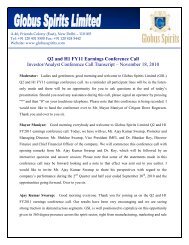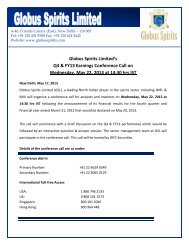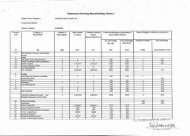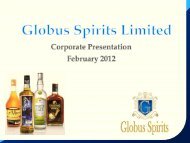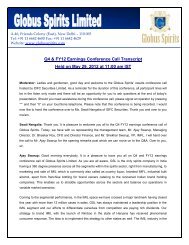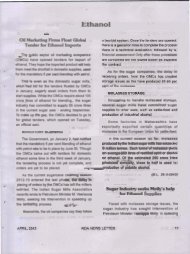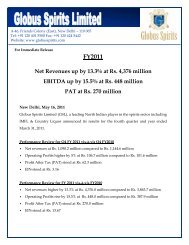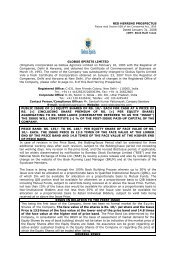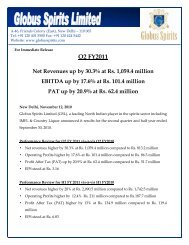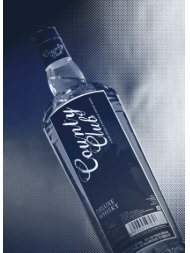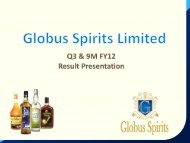Q1 FY13 Concall Transcript - Globus Spirits
Q1 FY13 Concall Transcript - Globus Spirits
Q1 FY13 Concall Transcript - Globus Spirits
Create successful ePaper yourself
Turn your PDF publications into a flip-book with our unique Google optimized e-Paper software.
A-46, Friends Colony (East), New Delhi – 110 065<br />
Tel: +91 11 6642 4600 Fax: +91 11 6642 4629<br />
Website: www.globusspirits.com<br />
<strong>Globus</strong> <strong>Spirits</strong> Limited’s<br />
<strong>Q1</strong> <strong>FY13</strong> Earnings Conference Call <strong>Transcript</strong><br />
Held on August 13, 2012 at 4:00 p.m. IST<br />
Moderator: Ladies and gentlemen good day and welcome to the <strong>Globus</strong> <strong>Spirits</strong> <strong>Q1</strong> <strong>FY13</strong> earnings<br />
conference call hosted by IDFC Securities Limited. As a remainder for the duration of this conference, all<br />
participant lines will be in the listen-only mode and there will be an opportunity for you to ask questions at<br />
the end of today’s presentation. Should you need assistance during this conference, please signal an<br />
operator by pressing * and then 0 on your touchtone telephone. Please note that this conference is being<br />
recorded. At this time, I will like to hand the conference over to Mr. Harit Kapoor of IDFC Securities. Thank<br />
you and over to you sir.<br />
Harit Kapoor: Thanks Inba. Thank you all for joining us for the <strong>Q1</strong> <strong>FY13</strong> call for <strong>Globus</strong> <strong>Spirits</strong>. We have<br />
with us today, Mr. Ajay Kumar Swarup – Managing Director; Mr. Shekhar Swarup, Executive Director and<br />
Dr. Bhaskar Roy – CFO of the Company.. I would now like hand over the line to Mr. Ajay Swarup to make<br />
the opening remarks, over to you sir.<br />
Ajay Swarup: Good afternoon all and a very warm welcome to <strong>Globus</strong> <strong>Spirits</strong>’ <strong>Q1</strong> <strong>FY13</strong> earnings<br />
conference call. I will take this opportunity to share with you our perspectives on the Company’s operational<br />
performance and plans following which Dr. Roy will take you through the financial highlights of the<br />
Company for the first quarter ended June 30, 2012.<br />
Allow me to restate that GSL is the only Company in the alcobev industry to have a 360 degree business<br />
model that straddles across all segments of the spirits value chain right from manufacturing i.e. bulk alcohol<br />
and franchise bottling to a consumer portfolio which is spread across value segment right from the<br />
economical IMIL to regular and semi-premium categories of IMFL. Our focus is on value enhancement and<br />
in that regards we continue to explore for opportunities which meet our desired vision.<br />
Before I move on to segmental results, I would like to highlight that while operationally we are on track, the<br />
last quarter saw an unanticipated pressure on performance primarily due to rising raw material cost and<br />
subdued growth in the IMIL industry. Decline in off-take of IMIL products is primarily because of low spends
<strong>Concall</strong> <strong>Transcript</strong><br />
Financial Performance for the Qand nine months ended December 31, 2009<br />
<strong>Q1</strong> <strong>FY13</strong><br />
by the rural consumers consequent to compressed incomes largely due to deficit rainfall and general<br />
inflationary trend across. Additionally, the government permitting export of broken grains, our key input of<br />
manufacturing bulk alcohol has resulted in a 25% – 30% increase in our raw material prices. We expect this<br />
trend in raw material prices to sustain over this quarter and this should be factored into our performance.<br />
Let me now take you through the segment-wise performance.<br />
To begin with the manufacturing part of the business, GSL is a significant player in the bulk alcohol<br />
segment with one of the largest distributions in the country at 84.4 million liters per annum. This capacity<br />
secures access to alcohol for branded operation in a scenario where demand supply gap for bulk alcohol is<br />
expected to widen considerably going forward. Hence, we are in the process of establishing ENA plants<br />
having 35 million liter capacity at our units in Behror and Samalkha. The added capacity should be<br />
operational by Q3 of the current financial year. Further, the Company has obtained licenses to setup<br />
Greenfield distilleries in Jharkhand and Bihar, which in our view are high potential markets due to the limited<br />
penetration. By adding these two portfolios, we plan to extend our 360 degree play into eastern India.<br />
Although, the plants are still in a planning stage, we expect to take firm steps towards their implementation<br />
in the very near future.<br />
As you are aware, GSL has also established deep relationships of franchise IMFL with leading liquor<br />
companies i.e. United <strong>Spirits</strong>, Jagatjit Industries Limited and ABD Limited. We are presently bottling over 3<br />
million cases of high quality bulk IMFL for their key brands per year. This business is proxy play on growth<br />
branded IMFL business as it is a sticky business with limited investment and consistent margins. The<br />
arrangement strengthens GSL alliances in the franchise bottling segment and will enable improved<br />
utilization of capacity while delivering high margins compared to sale of bulk spirits.<br />
Overall, the manufacturing business not only ensures reasonable assured off-take and steady growth but<br />
provides free cash flows for augmenting growth of branded businesses.<br />
The consumer facing business, as mentioned earlier, comprises of two divisions, IMIL and IMFL. In the IMIL<br />
space, we continue to be an undisputed leader in north India with a strong marketing and distribution<br />
network and volumes of over 12 million cases per year. The subdued performance of this segment in the<br />
quarter gone by is reflective of the challenges faced by the rural population in terms of deficit monsoon<br />
which has had an adverse impact on off take of our IMIL products. Besides, the prolonged summer which<br />
resulted in shift in consumption from IMIL to Beer also weighed on the performance of this business. This<br />
has resulted in flat volumes across our regions of operations. Nevertheless, we expect to outperform<br />
2
<strong>Concall</strong> <strong>Transcript</strong><br />
Financial Performance for the Qand nine months ended December 31, 2009<br />
<strong>Q1</strong> <strong>FY13</strong><br />
industry by leveraging our strong positioning through introduction of innovative products. Further, we are<br />
exploring opportunities of entering new states with IMIL either directly or through franchising our strong<br />
brands like Nimboo to garner market share from companies who continue to rely on the commoditized<br />
approach.<br />
The IMFL segment on the other hand continues to be a peripheral play for our Company, given its current<br />
size but is a promising constituent of the 360 degree model. We are conscious that the volumes in these<br />
segments have been lower than anticipated, but this is by design as we do not want high investment/risk in<br />
the brand building initiatives. Our focus is on value enhancement aimed at profitable, sustainable growth.<br />
To close, while the challenges in the macro environment continue to hurt consumer sentiment, our focus on<br />
establishing manufacturing capacities and emphasizing on value enhancement across our consumer facing<br />
portfolio combined with strengthening our marketing and distribution network will hold us in good stead to<br />
leverage growth opportunities across segments and report better financial as the environment improves.<br />
This brings me to the end of my discussion. I will now request Dr. Roy to take you through the financial<br />
performance for the quarter ended June 30, 2012.<br />
Dr. Bhaskar Roy: Good afternoon everybody. I hope you had a chance to go through our results for<br />
<strong>Q1</strong><strong>FY13</strong>. I will briefly take you through the financial following which we will be open to any questions that<br />
you may have.<br />
For the quarter, net income was higher by 24.4% versus <strong>Q1</strong> FY12 at Rs. 143.9 crore. EBITDA stood at Rs.<br />
18.8 crore and EBITDA margin stood at 13.1%. PAT stood at Rs. 9.5 crore translating into a non analyzed<br />
EPS of Rs. 4.14.<br />
Let me now give you a segmental breakup.<br />
During <strong>Q1</strong> <strong>FY13</strong> we sold 102.19 BL of bulk alcohol translating into a revenue share of 21.2%. In the IMIL<br />
segment we clocked volumes of 26.3 lakh cases translating into revenue share of 43.1%. Our branded<br />
IMFL sales stood at 1.12 lakh cases including sales from tie-ups forming 4.2% of the total revenue shares.<br />
Franchise IMFL sales volumes stood at 4.1 lakh cases contributing 19.1% to the total revenue share. The<br />
sales from other segment contributed 12.3% to the total revenue share.<br />
This brings me to an end of my discussion. Thank you once again for joining us on this conference. We will<br />
be happy to answer any questions that you may have now.<br />
3
<strong>Concall</strong> <strong>Transcript</strong><br />
Financial Performance for the Qand nine months ended December 31, 2009<br />
<strong>Q1</strong> <strong>FY13</strong><br />
Moderator: Ladies and gentlemen we will now begin the question and answer session. Our first question is<br />
from Abneesh Roy of Edelweiss Securities. Please go ahead.<br />
Abneesh Roy: How is the underlying demand for IMIL in the different states? Secondly, what is the reason<br />
for this slowdown IMILand by when do you see the growth coming back across the segment.<br />
Ajay Swarup: <strong>Globus</strong> <strong>Spirits</strong> operates the IMIL business in Delhi, Haryana and Rajasthan. Yes, as<br />
mentioned in the opening remarks, there has been a slowdown in the IMIL segment in this quarter as<br />
compared to the previous year due to inflationary pressure in terms of disposable income going down for<br />
the SEC in question and also the bad monsoon which might be taking its toll. Going forward, while we do<br />
see that may be another quarter will have the same kind of pressure, but basically there is no shift in<br />
demand. It is just a reduction caused by reduced spending. We do believe that this should change in Q3 or<br />
Q4 of the current financial year.<br />
Abneesh Roy: So are they down trading to unbranded? Also, based on our understanding, the deficit in<br />
monsoon will have a higher impact in the second half of the financial year because of the lag. So what is the<br />
reason for our belief that in second half the underlying growth will pick-up?<br />
Ajay Swarup: We do believe that the growth will come back in the second half. In fact, what we believe is<br />
that with purchasing power coming down, the IMFL consumer may down trade into IMIL. So that is<br />
something which we expect to happen, but no the IMIL consumer is not down-trading into an unbranded<br />
liquor because there is no such product.. So the cheapest available liquor in the market is IMIL and hence<br />
we do not see a risk of down-trading from IMIL at all.<br />
Abneesh Roy: Are there different price brackets in IMIL or normally there is parity in the pricing?<br />
Ajay Swarup: There is parity in IMIL prices.<br />
Abneesh Roy: If you see the largest players in IMFL, they are focusing more on the higher margin<br />
businesses and their logic is that because price hikes have been a bit difficult, there is hardly any margin to<br />
be made in the lower end of the segment. So, while we know your IMFL business is at a nascent phase, but<br />
are you also witnessing this kind of a trend?<br />
Ajay Swarup: This is totally an issue which we are grappling with ourselves that margins in the lower priced<br />
IMFL business are in fact extremely low if at all there. So, we ourselves are going through this process of<br />
understanding and systematically reducing our presence in states and in products where the margins are<br />
4
<strong>Concall</strong> <strong>Transcript</strong><br />
Financial Performance for the Qand nine months ended December 31, 2009<br />
<strong>Q1</strong> <strong>FY13</strong><br />
possibly reduced to almost zero and while we do that, we are developing new products side-by-side in the<br />
premium or the semi-premium categories where margins are better.<br />
Abneesh Roy: With regards to your IMFL entry into new markets etc., how are they faring in terms of your<br />
long term targets and any change in the IMFL in those specific states?<br />
Ajay Swarup: We are adding Bihar either in Q2 or Q3 and then the off-take in CSD should happen soon.<br />
Other than that; we recently launched our products in Delhi. So, these are the few additions to our<br />
distribution.<br />
Abneesh Roy: How is CSD looking from <strong>FY13</strong> full year perspective for GSL and do you see any recovery<br />
in CSD in the balance quarters.<br />
Ajay Swarup: Well, our product has been approved by CSD; we are only awaiting a formality which is<br />
known as the price negotiation committee which is in fact slated for later this month and post that we expect<br />
to start getting orders from them. So, yes in the current year possibly the second half we will actually start<br />
getting business from the CSD.<br />
Moderator: Thank you very much. Our next question is from Naga Brahma. He is an individual investor.<br />
Please go ahead.<br />
Naga Brahma: How is the demand for bulk alcohol?<br />
Ajay Swarup: The demand for bulk alcohol is really based on the demand from the big buyers of alcohol<br />
which in our case are the big liquor producers; we have alliances with United <strong>Spirits</strong>, Jagatjit Industries,<br />
Seagram as well as with ABD and as a combination, these four liquor companies will constitute 80% of the<br />
IMFL market. So with our strong alliances with these companies, the demand for bulk alcohol or ENA is<br />
extremely robust and it is based on that, we expect to get close to 100% utilization of our ENA capacity.<br />
Naga Brahma: The capacity utilization given in the presentation is around 70% in FY12. So, is that for the<br />
bulk alcohol or ENA or is it for different product?<br />
Dr. Bhaskar Roy: 70% utilization is for the total capacity. This is because, while we are running the new<br />
plant, which is ENA, at about 90-99% capacity, the old plants i.e. Rectified <strong>Spirits</strong>, are operating at lower<br />
utilization rates given subdued demand.<br />
5
<strong>Concall</strong> <strong>Transcript</strong><br />
Financial Performance for the Qand nine months ended December 31, 2009<br />
<strong>Q1</strong> <strong>FY13</strong><br />
Ajay Swarup: Let me just explain to you the difference between ENA and Rectified Spirit. So, when we talk<br />
about bulk alcohol it could either be ENA or it could be RS. In the current market situation, the demand for<br />
RS is subdued; however the demand for ENA is very robust and that is because of the fact that it is<br />
demanded by the IMFL producers. So, what Dr. Roy was saying is that since RS demand is subdued we<br />
are currently not running the RS capacity, but running the ENA capacity to 100% which on a total capacity<br />
basis comes to a capacity utilization of 70%.<br />
Naga Brahma: Sir, another small clarification you have mentioned in the earlier conference calls that<br />
whatever the new capacities that we have added, we could produce the ENA directly without going for into<br />
RS.<br />
Ajay Swarup: That is absolutely correct.<br />
Naga Brahma: So, out of the total capacity, how much would be RS?<br />
Ajay Swarup: Out of the 120 million liters, which is post the brownfield expansion of 35 million litres,<br />
approximately 90 million could be produced directly from without going to rectified spirits.<br />
Naga Brahma: So when you say 100% capacity of utilization of ENA means it is for this 90 million only.<br />
Ajay Swarup: Yes.<br />
Naga Brahma: You also mentioned that there is a Brownfield project of 35 million litres of wash to ENA<br />
plants. What is this?<br />
Ajay Swarup: These are the additional 35 million litres of ENA capacities that we are adding which will<br />
come into operation in Q3 of the current financial year.<br />
Naga Brahma: I just read an article yesterday about cabinet meeting on the ethanol pricing. In case if the<br />
government finally decides about the pricing; will it further boost the demand for ENA?<br />
Ajay Swarup: Certainly. You see ethanol pricing issue has been persisting for the last one year and as a<br />
result of that the oil companies are in limbo and they are not able to take decision on how much to procure<br />
and the sugar companies and other companies on the other hand are not sure about how much to produce.<br />
The moment this issue is resolved, we are going to see a huge upsurge in demand for ethanol which in turn<br />
6
<strong>Concall</strong> <strong>Transcript</strong><br />
Financial Performance for the Qand nine months ended December 31, 2009<br />
<strong>Q1</strong> <strong>FY13</strong><br />
is going to put pressure on the availability of ENA in the market and this is something which is likely to<br />
happen very soon.<br />
Naga Brahma: With the increase in the demand for ENA and of course for ethanol, will the raw material<br />
cost also go up?<br />
Ajay Swarup: Well, the raw material for ethanol is molasses and whereas the raw material for ENA could<br />
either be molasses or grain. We don't see the impact of ethanol production increasing having any impact on<br />
the pricing of grain, which is our raw material.<br />
Naga Brahma: Is there any particular reason as to why IMFL and franchise bottling haven’t picked up since<br />
last two to three quarters?<br />
Ajay Swarup: Franchise bottling is on track and as per plan. The reduction in volume in branded IMFL has<br />
been due to the fact that we are reducing our presence in certain markets which have a reduced margin<br />
and we are introducing new market where margins are a lot better. So <strong>Q1</strong> was the process of adjustment<br />
and possibly Q2 will also see a bit of that adjustment of moving from one market to other.<br />
Naga Brahma: Also, the quantity in bottling are not much compared to last year same quarter.<br />
Dr. Bhaskar Roy: The numbers have increased. In the franchises IMFL, we had bottled 4.07 lakh cases in<br />
<strong>Q1</strong> <strong>FY13</strong> compared to 3.52 lakh cases in <strong>Q1</strong> FY12 . Now, it will further increase because of our recent tieup<br />
with USL and revival of Jagatjit.<br />
Naga Brahma: Is the increase in raw material price the key reason for EBIDTA margins to decline to 13%<br />
or so?<br />
Dr. Bhaskar Roy: Yes that is the main reason. However, if you see, the EBITDA margin has improved from<br />
Q4 FY12, but further improvements were difficult because of the pressure of raw material prices.<br />
Naga Brahma: Are we able to pass on the hike in raw material prices to the customers?<br />
Dr. Bhaskar Roy: As you would be aware, 50% of our product is consumer facing business and about<br />
30%-40% constitutes of sale of bulk spirit. In case of bulk spirits, you have the ability to pass on the costs to<br />
some extent. However, in case of branded product, as the prices are fixed in the beginning of the year, it is<br />
7
<strong>Concall</strong> <strong>Transcript</strong><br />
Financial Performance for the Qand nine months ended December 31, 2009<br />
<strong>Q1</strong> <strong>FY13</strong><br />
difficult to pass on the costs immediately and you have to wait until the end of the year for the government<br />
to consider a price increase.<br />
Naga Brahma: Is there any other CAPEX plan for the current year?<br />
Dr. Bhaskar Roy: There is no major capex planned in the current year.<br />
Moderator: Thank you very much. Our next question is from Kushal Sanghrajka of HDFC Securities.<br />
Please go ahead.<br />
Kushal Sanghrajka: The margins have been fairly low for the past 5 odd quarters and in every quarter we<br />
see a sort of different trend in the price or pressure being on the raw material and sometimes other<br />
expenses going up. Before five quarters if you see the margin used to be 17% to 19%. Can we assume that<br />
now these lower margins are here to stay?<br />
Ajay Swarup: No, it is not. Let me answer that question in a slightly different way. Firstly, you must<br />
understand that our revenue is made up of four different verticals viz. bulk alcohol, IMIL, IMFL and<br />
franchisee IMFL. The increase in capacity of producing bulk alcohol has come-in in the last couple of<br />
quarters. As a result, there is a surge in the share of revenue which comes in from bulk alcohol. Bulk<br />
alcohol is a lower EBITDA margin piece which is well-accepted. So, mathematically the weighted average<br />
comes down. So part of this is due to the simple readjustment of the revenue pie so to speak.<br />
Let us now go to the changes which have happened; the changes currently which we are facing and as I<br />
said in the introductory remarks, basically the pressure in agricultural commodity which is spilling on our<br />
bottom-line as well. So, grain being our basic raw material and grain witnessing an increase in prices over<br />
the last one quarter is something which has hit us directly. We believe that this will continue for another<br />
quarter and we do believe that come the new season of the crops which happens around early Q3, this<br />
pressure will ease of along with the fact that the government has now announced a ban on the export of<br />
rice which again was putting pressure on prices. So going back to your question I do believe that going<br />
forward margins will go back to where they were, possible not 17% but certainly inch upwards of 13% and<br />
get closer to 15% and that is what we see going forward; but then the way commodity prices go sometimes<br />
one can’t tell.<br />
Kushal Sanghrajka: What perception most of us have is that, people downgrade during bad times from a<br />
higher brand to a lower brand and from a lower brand may be to IMIL. So this is what you mean, indicating<br />
a slowdown in sales of alcohol across the country?<br />
8
<strong>Concall</strong> <strong>Transcript</strong><br />
Financial Performance for the Qand nine months ended December 31, 2009<br />
<strong>Q1</strong> <strong>FY13</strong><br />
Ajay Swarup: Firstly, yes one can make predictions about consumer purchasing behavior but at end of the<br />
day, the consumer decides how he would spend; having said that if we are going to see exactly what<br />
happened in the last quarter, I can tell you for the three states where we operate; Haryana there is a sharp<br />
decrease in volumes of IMIL sales across; Rajasthan in fact has an increase though not too big but there is<br />
an increase and Delhi is completely flat. So all in all, for us, because Haryana is actually a much bigger<br />
market than Rajasthan, so we saw the industry for us come down as compared to last year. Now going<br />
forward, we do hope that there will be down-trading and hence whatever we lose because of the lower<br />
disposable income may be offset by the fact that the consumer downgrades from a more expensive<br />
product. But like I said, these are conjecture and we can only wait and watch. I know that other consumer<br />
product companies are also witnessing lower rural demand. So it may be a generic phenomenon across the<br />
country. So we got to wait and watch and see what happens.<br />
Kushal Sanghrajka: Just a quick clarification, we always talk about Haryana, Rajasthan, and Delhi. I know<br />
that Chandigarh is very small in terms of comparison but we still do have sales in Chandigarh right?<br />
Ajay Swarup: We did till two years ago. It became an extremely low margin market and they gave<br />
preferences to bottling plants that were located within the union territory of Chandigarh, so <strong>Globus</strong> exited<br />
Chandigarh two years ago.<br />
Kushal Sanghrajka: While we have a 360 degree presence for the past couple of years, we have been<br />
trying to move towards the branded part of the business, including IMIL, in an attempt to improve margins.<br />
However, IMIL in the past few quarters, it has been little difficult especially in terms of moving to IMFL sales<br />
and especially this quarter where we can see that bulk sales have gone up significantly. What is the<br />
indication you have for your IMFL sales going forward? In the past year or so they haven't grown<br />
significantly per quarter. So, where do you see that going in the next couple of year?<br />
Ajay Swarup: Let me answer that question in a slightly different way. Firstly, the Company sometime<br />
around two quarters ago decided that besides looking at the branded IMFL business we are going to look at<br />
doing a paradigm shift in the IMIL business and make it a more consumer facing and a branded play.<br />
Towards that end, we launched a couple of very different-from-market kind of product with better blends,<br />
with better packages and exactly as we anticipated there was a huge acceptance and traction across<br />
Haryana. Now, the same IMIL brand is being introduced in Rajasthan in Q2 <strong>FY13</strong> under the same name as<br />
we launched in Haryana.<br />
Kushal Sanghrajka: Is the product Nimboo that we are talking about?<br />
9
<strong>Concall</strong> <strong>Transcript</strong><br />
Financial Performance for the Qand nine months ended December 31, 2009<br />
<strong>Q1</strong> <strong>FY13</strong><br />
Ajay Swarup: Yes. It is called Nimboo. Going forward, <strong>Globus</strong> is going to be a significant player in the<br />
branded IMIL industry which hitherto being a 250 million cases business and therefore being bigger in<br />
volume than IMFL, it is going to be a significant differentiating factor from other liquor companies who are<br />
not at all present in this. So in this process, we are changing the face of the IMIL business and looking to<br />
become industry leaders in these states. Further, if you look at our consumer facing business which<br />
includes IMIL, we would be doing volumes of 12 million cases which is hitherto commoditized but is now<br />
moving towards being branded. Now coming to the branded IMFL business, yes you are right, we have<br />
been attempting to grow this business over the last three years and there have been challenges in the form<br />
of low margins in the segments where we entered. The challenges are based on high spends on sales and<br />
marketing but we are going about it in a systematic manner and yes, with this systematic approach we are<br />
putting in, I see this segment grow gradually. So for us, the consumer facing business is now going to be<br />
branded IMIL and there will presence of the branded IMFL business which will grow steadily but really<br />
speaking the lead will be taken by the branded IMIL.<br />
Kushal Sanghrajka: So bulk alcohol sales have been fairly high this quarter, one is of course because of<br />
added capacity and due to demand from other alcohol companies. Could you let us know if the bulk alcohol<br />
this quarter would be largely ENA considering we are running the ENA capacities at full capacity now.<br />
Ajay Swarup: It is only ENA.<br />
Kushal Sanghrajka: So that would mean that other players are in fact doing well in their IMFL businesses<br />
if they are buying so much ENA.<br />
Ajay Swarup: They were buying ENA even earlier actually. It is just that now they are buying it from us.<br />
Kushal Sanghrajka: When you say Nimboo is doing well, can you put a number to that and how has it<br />
been growing over the last 2 quarters?<br />
Ajay Swarup: Within Haryana, we are close to say 25% of the market and this is largely Nimboo. We are<br />
now introducing this in Rajasthan this month and we hope to see significant growth coming out of that as<br />
well.<br />
Kushal Sanghrajka: In Haryana you already had a very high market share earlier. So is it fair to assume<br />
that largely most of the people have shifted from non-branded GSL products to the branded GSL products<br />
now.<br />
10
<strong>Concall</strong> <strong>Transcript</strong><br />
Financial Performance for the Qand nine months ended December 31, 2009<br />
<strong>Q1</strong> <strong>FY13</strong><br />
Ajay Swarup: You are absolutely right. While we eat others market share, we also cannibalize.<br />
Kushal Sanghrajka: Cannibalizing at a good cost I assume. Are the margins of a branded IMIL better than<br />
regular or non-branded IMIL?<br />
Ajay Swarup: Actually there are no differential price points in IMIL. The only difference being that when you<br />
are in the commodity play, the demand is not sticky; when you are in a branded play you are assured of<br />
your business. So that is why it becomes a lot more sustainable.<br />
Moderator: Thank you very much. Our next question is from Grishma Shah from Envision Capital. Please<br />
go ahead.<br />
Grishma Shah: What is the cost of your greenfield capacities in Bihar and Jharkhand and when are they<br />
expected to come on stream?<br />
Ajay Swarup: Like I said the Company has recently received licenses to set up distilleries in Jharkhand and<br />
Bihar. Other than getting licenses from the excise department, there are several other departments which<br />
give clearances, specifically this is applicable for the distillery industry and we are in the process of getting<br />
all those clearances. They should be done in the next couple of quarter, post which we will embark upon the<br />
process of setting this up. Each distillery would be a Greenfield initiative and would cost in terms of CAPEX<br />
between Rs. 75 to Rs. 100 crore.<br />
Grishma Shah: That would be somewhere between FY14 and FY’15?<br />
Ajay Swarup: That is right.<br />
Grishma Shah: What would be your current cost of debt?<br />
Dr. Bhaskar Roy: Around 12%.<br />
Grishma Shah: We have seen that the working capital and term loan both have gone up. So what kind of<br />
number do we see by the end of the year?<br />
Dr. Bhaskar Roy: While debt has increased from the <strong>Q1</strong> FY12, it has gone down from Q4 FY12 by ~ Rs. 3-<br />
4 crore and we target it to bring it down considerably by the end of the year.<br />
Grishma Shah: So, by that time probably you would have got some clue on your CAPEX plans.<br />
11
<strong>Concall</strong> <strong>Transcript</strong><br />
Financial Performance for the Qand nine months ended December 31, 2009<br />
<strong>Q1</strong> <strong>FY13</strong><br />
Ajay Swarup: Yes. What Dr. Roy is really implying is that we are now using surplus cash flows to repay<br />
that; however, sometimes when we get clearance to start work on our projects, there will again be need to<br />
divert internal accruals and possibly take on a little more debt to set up these projects.<br />
Moderator: Thank you very much. Our next question is from Avinash Wadhwa of M3 Investments. Please<br />
go ahead.<br />
Avinash Wadhwa: I was wondering since branded IMIL i.e. Nimboo is doing so well, why did it take so long<br />
for you to figure that you need to brand at this stage to drive growth, why did this revelation not strike<br />
earlier.<br />
Ajay Swarup: Good point. Firstly, the consumer we realize is becoming a lot more younger and aware.<br />
Secondly, we moved to making more ENA than rectified spirit. As a result, we could actually put into the<br />
market with the new technology which we had in our plant where we made ENA at the same cost as<br />
rectified spirit. We could put ENA into IMIL which is something very few people do. So, a combination of<br />
changing taste and preferences of the consumer with the ability on our part to put near Vodka or near<br />
whisky like product into the IMIL market, gives us this ability to create a differentiator. It is not just putting a<br />
label on the product. It is something that you need to differentiate the product from the competitor. So that is<br />
what happens and that is when we were able to do those. Rest it could have been done 15 years ago. But<br />
there are circumstances in terms of technology, in terms of changing consumer behaviors and those<br />
culminated in us doing this only last year.<br />
Avinash Wadhwa: As you elect to put up new Greenfield capacities, why have you zeroed in on Jharkhand<br />
and Bihar as opposed to other states?<br />
Ajay Swarup: When one does contemplate as to where you would like to put up more capacity, firstly the<br />
question is why would you like to put up Greenfield capacity not Brownfield? So the first decision was taken<br />
based on the fact that in the two states we operate we already have a very significant installed capacity. So<br />
then the decision was to grow, you have to grow into new areas and hence it is Greenfield. Within<br />
Greenfield you have to look at present demand of alcohol versus present production of alcohol in that state<br />
and when we did that analysis that is when the eastern states came up as possible good option for us to set<br />
a plant and then of course is the question of who welcomes you most. So yes, these states have welcomed<br />
us and the process of licensing, etc., has been quite easy and we do hope that very soon all clearance will<br />
be in place.<br />
12
<strong>Concall</strong> <strong>Transcript</strong><br />
Financial Performance for the Qand nine months ended December 31, 2009<br />
<strong>Q1</strong> <strong>FY13</strong><br />
Avinash Wadhwa: You also said that your current capacities in the states of Haryana and Rajasthan<br />
comprised a significant portion of capacities in those states. It is clear that your capacity creation has<br />
outpaced demand for your IMFL in these states. So I am just trying to wonder what the logic would be to get<br />
so ahead in capacity creation in these states. So far ahead of your own IMFL demand?<br />
Ajay Swarup: We don't setup capacity only to take cater to our bottled spirit demand. We create capacity to<br />
cater to the demand of the entire market and like I have said many times we are 360 degree player in the<br />
spirit business. We straddle all verticals and of which one of them is bulk alcohol.<br />
Avinash Wadhwa: But if a large part of your volume sales comes out of bulk alcohol. What really could be<br />
the thought there? Isn't it a commoditized kind of business or wouldn't the thought eventually be that you<br />
know my own capacities get absorbed for my own brands.<br />
Ajay Swarup: Absolutely you are correct in saying that. However, there is a certain capacity in terms of<br />
economic size where you have to setup a plant to make alcohol. Now till your own branded play or your<br />
bottled play reaches a certain level of capacity you do need to sell the bulk alcohol as a commodity. So over<br />
the years in the state where we are present currently there will be a gradual decline in the percentage of<br />
sales which go into bulk alcohol and gradually the sales of bottled alcohol is increased.<br />
Avinash Wadhwa: During that the pace of capacity creation in the state has been as brisk as yours, you<br />
would certainly have displaced somebody else's bulk alcohol, right? The consumption would not have<br />
grown at the pace at which you created the capacity in the recent past.<br />
Ajay Swarup: We displaced imports from other states.<br />
Avinash Wadhwa: So in the foreseeable future where does this process of creating capacity sort of end in<br />
the medium term. If this expansion from 84.4 million BL to 120 million BL end in the foreseeable future?<br />
Ajay Swarup: For us, it ends for at least a couple of years, but if we see opportunity we will increase it<br />
further.<br />
Avinash Wadhwa: Your other expenditure has outpaced revenue growth significantly. I am just wondering<br />
what the heads of these other expenditures are that has led to this outcome.<br />
Dr. Bhaskar Roy: The other expenditure in FY12 was higher as the power and fuel costs were higher due<br />
to stabilization of our newly installed capacities. If you analyze the figure over the years, it was 31% on net<br />
13
<strong>Concall</strong> <strong>Transcript</strong><br />
Financial Performance for the Qand nine months ended December 31, 2009<br />
<strong>Q1</strong> <strong>FY13</strong><br />
sales in Q4 FY12 which has now reduced to 27% in <strong>Q1</strong> <strong>FY13</strong>. With the production stabilizing, we are able<br />
to control the expenditure to a large extent possible.<br />
Moderator: As there are no further questions from the participants. I would now like to hand the floor over<br />
to Mr. Harit Kapoor for closing comments.<br />
Harit Kapoor: Thanks Inba. On behalf of IDFC securities I would like to thank the management of <strong>Globus</strong><br />
<strong>Spirits</strong> for taking out their time for this call. Mr. Ajay Swarup would you have some closing remarks?<br />
Ajay Swarup: Thank you everybody for sparing the time to be on this call and it is a part of <strong>Globus</strong>' investor<br />
relation initiatives to be available to investors for giving updates on what happen with the Company and we<br />
shall be doing this as a regular feature. Thank you very much.<br />
Moderator: Thank you very much sir. Ladies and gentlemen on behalf of IDFC Securities Limited that<br />
concludes this conference call. Thank you for joining us and you may now disconnect your lines.<br />
This is a transcription and may contain transcription errors. The Company or the sender takes no<br />
responsibility of such errors, although an effort has been made to ensure high level of accuracy.<br />
14




